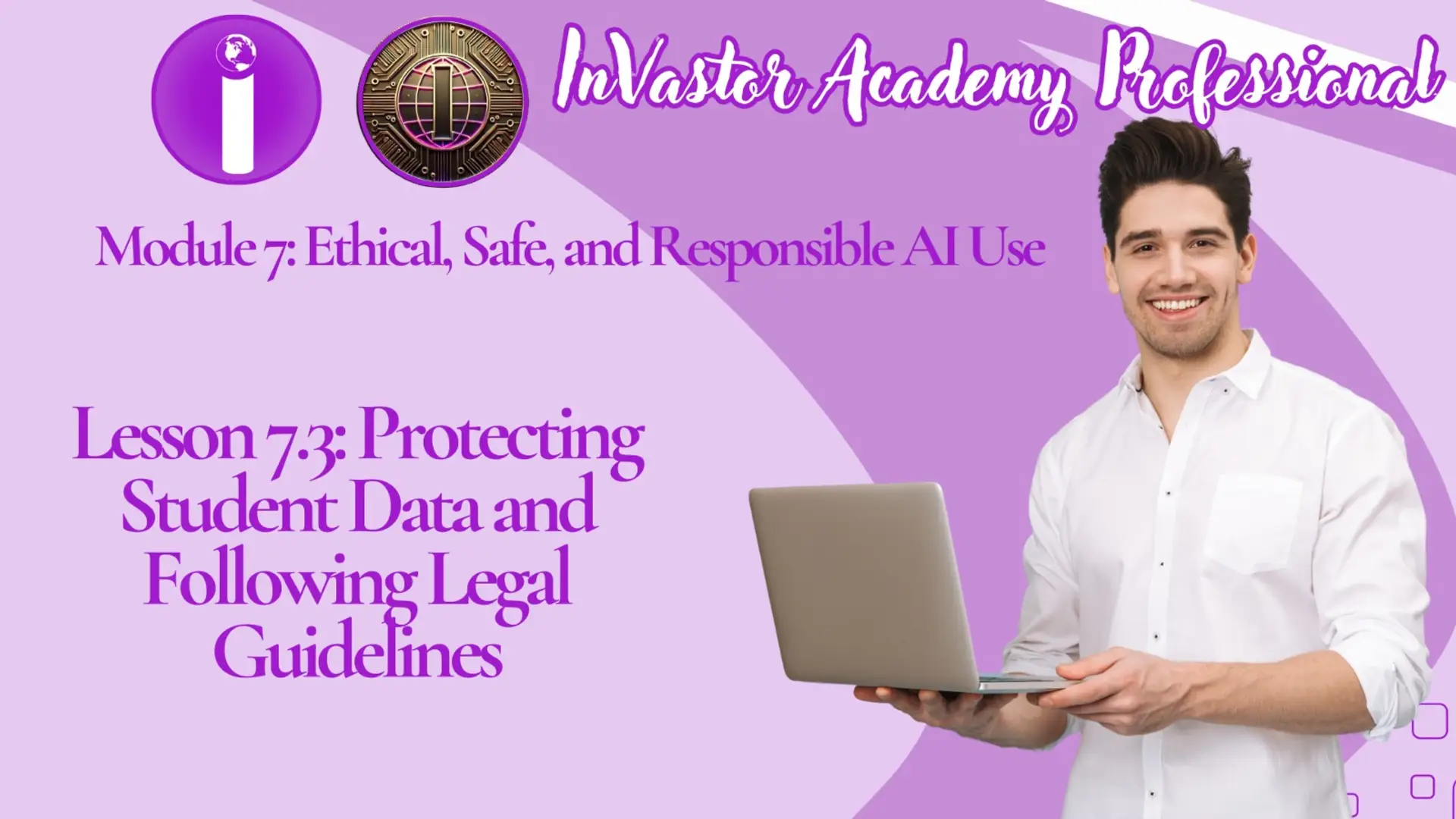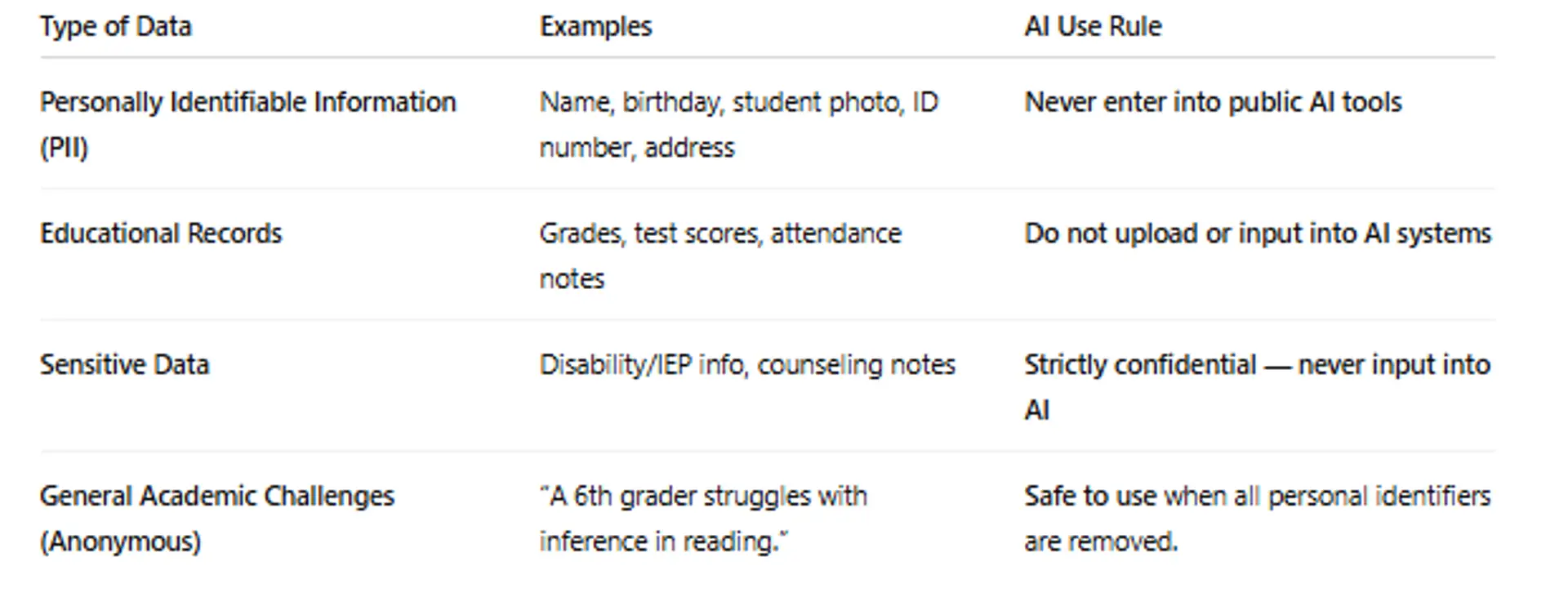

Module 7: Safety, Privacy, and Responsible AI Use in Education Lesson 7.3
Module 7: Safety, Privacy, and Responsible AI Use in Education
Lesson 7.3 — Protecting Student Data and Following Legal Guidelines
Learning Objectives
By the end of this lesson, educators will be able to:
- Define and distinguish between student Personally Identifiable Information (PII), education records, and sensitive data.
- Identify the major legal frameworks that regulate student data privacy (FERPA, COPPA, GDPR, State/Local Policies).
- Evaluate whether an AI tool is appropriate and compliant for classroom use.
- Apply safe data-handling strategies, including anonymization and secure tool selection.
- Implement step-by-step procedures to prevent accidental sharing of student information.
- Model and promote responsible digital data practices among students, staff, and learning communities.
1.What is Student Data and Why Does It Need Protection?
Student data refers to any information that relates to a specific student, whether academic, biographical, behavioral, or personal.
This includes:
- Names
- Photos / videos
- Grades / assignments
- Attendance records
- Parent contact details
- Medical or counseling notes
- IEP/504 accommodation plans
Student data must be protected because:
- Students cannot consent to how their data is used.
- Misuse can affect safety, well-being, and long-term opportunities.
- Schools are legally obligated to safeguard all student information.
- Parents and guardians expect confidentiality and trust.
Failing to protect student data can result in:
- Legal penalties for the school
- Loss of funding
- Disciplinary action for educators
- Harm to students and their families
2. Understanding Key Privacy Laws (Simplified)

If the tool is not district-approved, assume it is not legal to use with student information.
3. Types of Data: What You Can and Cannot Use With AI

4. The Anonymization Method (Your Required Classroom Safety Strategy)
When asking AI for help:
- Describe the learning situation, not the student.
❌ Do NOT Write:
"Maria Santos is failing reading and has an IEP for dyslexia. What should I do?"
✅ Write Instead:
"A student struggles with decoding multisyllabic words. Suggest targeted practice strategies."
Rule of Thumb:
If anyone could identify the student from your description → Revise until anonymous.
5.Evaluating Whether an AI Tool is Safe to Use
Before using ANY AI tool, ask:
- Does the tool store data input into it?
- Does it use data to train future AI models?
- Is the tool FERPA/COPPA/GDPR compliant?
- Is this tool listed on the district’s approved EdTech list?
If the answer to any of these is uncertain → Do not use the tool with student data.
Safe AI Use Examples:
✔ Google Workspace for Education (protected mode)
✔ Microsoft Teams/Classroom
✔ District-licensed learning platforms
Unsafe AI Use Examples:
✘ Public ChatGPT / Gemini / Bard input containing student details
✘ Free classroom apps without privacy agreements
✘ Uploading student work to free online grading AI tools
6. Classroom Safety Protocol Checklist
Before using AI in your teaching workflow, confirm:

7.Supplementary Resources
Protecting Student-Data Privacy: An Expert’s View
How Does Biased AI Cause Real-world Harm? - AI and Machine Learning Explained
AI Is Dangerous, but Not for the Reasons You Think | Sasha Luccioni | TED
Lesson 7.3 Quiz
Protecting Student Data and Following Legal Guidelines
Please complete this quiz to check your understanding of Lesson 7.3.
You must score at least 70% to pass.
Conclusion
AI can greatly assist educators — but only when used responsibly.
Protecting student data:
- Maintains student and family trust
- Supports ethical teaching practices
- Ensures legal compliance
- Creates a safe learning environment
Responsible AI use is not just about technology —
It is about respect, safety, and professionalism.
Educators must always prioritize student privacy over convenience.
Next and Previous Lesson
Next: 7.4: Writing a Classroom or School AI Policy
Previous: Lesson 7.2: What Teachers Should NOT Upload to AI Tools
AI for Educators: Personalized Learning & Content Creation
Related Posts
© 2025 Invastor. All Rights Reserved

User Comments